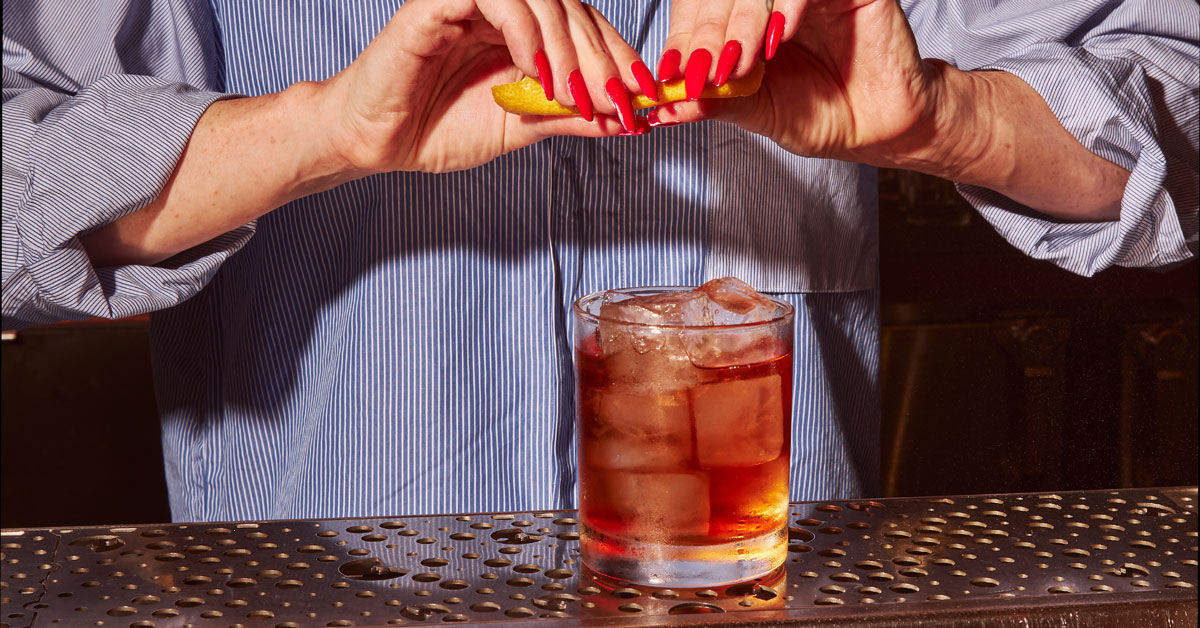It’s no surprise that the Dunhill has made it to the classics section of the menu at Toronto’s Bar Raval. The Barcelona-inspired bar prides itself on its carefully curated selection of vermouths and sherries, and as a result, the cocktail program highlights drinks like the Bamboo, Adonis and Dunhill. “That’s been a real part of the ethos of the cocktail program since its inception.” says managing partner Hailey Burke. The Dunhill is well-known in some quarters of cocktail culture, but it has yet to fully make a comeback, and Bar Raval is doing its part to increase its name recognition in Ontario and beyond.
The Dunhill (usually known by its longer name, Dunhill’s Special) is a spirit cocktail that highlights two of England’s favorite drinks: gin and sherry. In the original recipe, the body of the drink is made up of equal parts gin, French vermouth, and sherry, then flavored with small amounts of curaçao and absinthe and garnished with an olive.
The Dunhill first appeared in Drinks: long and shorta 1925 book by Nina Toye and A.H. Adair, published in London, containing other obscure classics such as Champs Elysees and the Paulina. In In the book, the drink is attributed to Hatchett’s Bar, which had operated as an inn and coffee house in Piccadilly since the 18th century. By the 1920s, it was a restaurant and bar that attracted celebrities and the hip crowd, and apparently served cocktails as well. Toye and Adair attribute two other drinks in their book to the bar. It can be assumed that the fashionable tobacco and luxury goods brand founded by Alfred Dunhill in the early 20th century is the source of the drink’s name.
Bar Raval’s interpretation of the Dunhill is a carefully constructed ode to the original, with a couple of stylistic tweaks. The most significant change is a shift in the drink’s proportions. The bar tends to favour higher-alcohol constructions in most classic specs, from Negronis to Paper airplanes—and the Dunhill is no exception. So the gin is upped to an ounce and a half and the sherry and vermouth are reduced to three-quarters of an ounce each. This, Burke says, works better for the drier palate that reigns supreme in Toronto.
For gin, Bar Raval chooses its favourite, perhaps the most London of all the London dry gins: Beefeater. Burke says its significant but not overwhelming presence of juniper and citrus makes it ideal for most classics.
Sherry, for its part, presented a greater challenge. According to Talia Baiocchi, editor-in-chief of Punch and author of the book SherryThe word “sherry” in the original recipe could mean anything from a dry, oxidative style, such as oloroso, to creamy sherry, which has a sweetness more akin to Italian vermouth. The recipe in your bookBaiocchi suggests Lustau’s East Indian expression.which is made from a blend of oloroso and Pedro Ximénez styles and is aged to mimic the days when sherry spent months or even years on ships. Bar Raval relies on the same Lustau product.“I definitely don’t want a Dunhill if it doesn’t have East India,” says Burke, citing the pleasant notes of raisins and petrol, as well as the overall warmth that this particular sherry brings.
To complement the sherry, the Bar Raval team uses another Spanish product: Vinos Guerra dry vermouth, their go-to brand for both dry and red and white styles. The dry expression reinforces the gin with its citrus notes and fresh quality.
For the Curaçao, Bar Raval sticks with industry favorite Pierre Ferrand, which brings its signature dry vanilla flavor and orange peel bitterness. For the absinthe, the bar uses a local brand (Dillon’s, produced in Niagara, Ontario), but has used others in the past. Burke says that regardless of the brand, the absinthe brings a nice warmth and anise flavor.
In a change from the original, Angostura was incorporated into Bar Raval’s recipe a while back and has remained a part of it ever since. Due to a shortage of East Indian sherry, the bar would mix Amontillado with PX and add Angostura to mimic the missing product. “When we brought back East Indian sherry, we were accidentally still mixing [Angostura] and we were like, Oh, this is good“, says Burke, “so we kept it.”
Also, unlike the original Dunhill, the Bar Raval version is served on the rocks, stirred in a double rocks glass with Kold-Draft ice cubes, as some might choose to make a Negroni. It retains the olive garnish of the original, but adds a twist of lemon to the mix.
There’s something warm and inviting, but also sexy, about the Dunhill, especially this cream sherry-spec. Burke says the drink’s vibe and old-school mix of ingredients make her think of 1970s dinner parties. “Everyone’s smoking and it’s kind of late,” she says, “and then everyone jumps in.”
Disclaimer:
The information contained in this post is for general information purposes only. We make no representations or warranties of any kind, express or implied, about the completeness, accuracy, reliability, suitability or availability with respect to the website or the information, products, services, or related graphics contained on the post for any purpose.
We respect the intellectual property rights of content creators. If you are the owner of any material featured on our website and have concerns about its use, please contact us. We are committed to addressing any copyright issues promptly and will remove any material within 2 days of receiving a request from the rightful owner.

